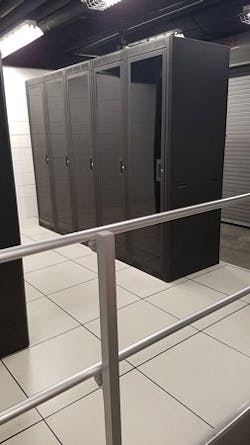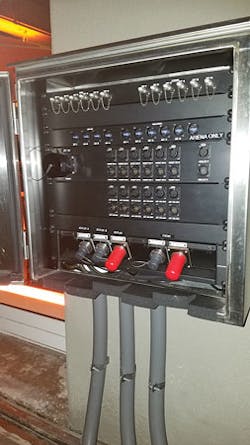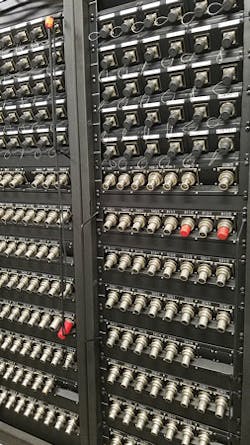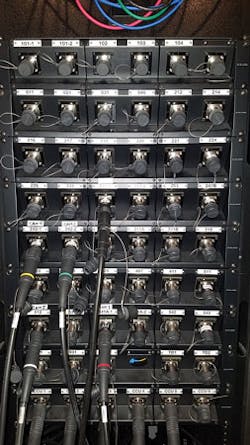In places of assembly, cabling infrastructure determines user and viewer experience
By Patrick McLaughlin
When tens of thousands of people gather on a single premises to watch a sporting event, communications infrastructure gets put to the test. Not the “plug-in-and-press-autotest” kind, but the real-world live kind, during which the stadium’s or arena’s communications infrastructure will provide a user experience that is satisfactory or unsatisfactory. Often this user experience is measured by an attendee’s ability to receive and use a wireless signal. That’s likely the biggest single part of the picture, but there is more to it. And as professionals in the cabling industry understand, the wired infrastructure is the enabling technology that makes these communications systems run.
Several cabling vendors have publicized their roles in providing infrastructure for arenas, stadiums and similar venues. This article will discuss some of those projects and provide other information on communications-infrastructure systems in these environments.
High speeds and high capacity
CommScope supplied infrastructure for upgrades at the Daytona International Speedway in Daytona, FL and Bank of America Stadium in Charlotte, NC, as well as for the new home of the NBA’s Sacramento Kings-the Golden 1 Center.
The Daytona Rising project, begun in 2013 and completed in January 2016, included the building of networks that “would both enhance the fans’ experience and improve track operations,” CommScope explained. The cabling infrastructure installed supports more than 1500 HD video displays, digital signage and synchronized messaging, WiFi, enhanced audio, security cameras, fire and safety services, as well as HVAC and lighting controls.
Craig Neeb, International Speedway Corporation’s executive vice president and chief development and digital officer, commented, “The solutions that we’re enabling will keep fans connected throughout the stadium and allow them to experience the event at a higher level, and with greater ease, than ever before. The technology will also help our operations team provide a safe, comfortable environment for our fans to enjoy the race.
The construction project included the installation of 250 miles of CommScope’s Systimax Category 6 cable, 100 miles of its TeraSpeed singlemode fiber-optic cable, and more than 12,500 terminations. CommScope technical manager Vince Sumrall explained, “The cabling at Daytona was old and outdated, installed piecemeal over a period of many years. Daytona Rising provided an opportunity to start over with a clean slate.”
Neeb added, “Early on, the key challenge for the design of the technology platform for Daytona Rising was looking beyond where we are today. We’re talking about an infrastructure plant that has to last 20 years beyond the opening, and we want to make sure that what we implement will be able to support things that we don’t know exist today or tomorrow … Daytona International Speedway will provide fans and partners alike access to some of the most advanced technology platforms available today.”
At Bank of America Stadium, home of the NFL’s Carolina Panthers, CommScope was part of an upgrade to the wireless network. The system now in place at BofA Stadium is the ION-U distributed antenna system (DAS), which CommScope explains enables “fans to upload photos and videos, text and make calls, and enjoy other mobile applications despite the high concentration of wireless users during football games and other events. The Panthers were able to deploy the DAS in less than 90 days from start to finish, and three wireless operators are now on-air throughout the stadium.”
The stadium also upgraded its local area network in the form of a passive optical LAN (POL), also using CommScope layer-one infrastructure, in areas including suites. Elsewhere in the stadium, the LAN employs a structured cabling architecture. CommScope noted, “This integrated infrastructure enables applications such as high-bandwidth data, voice, VoIP and WiFi services, high-definition TV and hospitality services for the suites, and broadband video.”
Golden 1 Center, the new home of the NBA’s Sacramento Kings, opened September 30. Boasting LEED Platinum designation, the venue seats 17,500 people and includes 630,000 square feet of retail and restaurant space. It also is the site of the first installation of CommScope’s LazrSpeed 550 Om5 wideband multimode fiber cable, which supports both wired and wireless communications.
Shortly before the arena’s opening, Sacramento Kings chief technology officer Ryan Montoya said, “Golden 1 center will be the smartest and most connected venue in the world, providing a seamless and intuitive experience for our fans and attendees. We believe connectivity is critical to the venue experience of the future.”
CommScope also supplied other cabling technologies-singlemode and Category 6A cable along with iPatch panels.
Wireless considerations
Montoya’s comment about connectivity’s criticality rings true across sports venues, and the recently renovated Texas A&M University Kyle Field is another example. With a capacity of more than 100,000, the renovated facility opened for the university’s 2015 football season. University chancellor John Sharp observed, “When renovating Kyle Field, we wanted to create one of the most cutting-edge college stadiums with the best technology for a very robust game-day experience.”
The university installed the Corning ONE Wireless Platform into the facility. Corning’s vice president for wireless networks, Mike O’Day, commented, “In order to bring fans from the living room and into the stadium, you need to have the best fan experience possible. By using the ONE Wireless Platform, an all-optical network, fans can share their experience at Kyle Field by uploading imagery, downloading live-video streams, or accessing the internet and social media as much as they want over the cellular or WiFi networks in the stadium.”
The ONE platform supports more than 1000 cellular antennas and 1500 wireless access points, enabling visitors to connect, whether it is through their mobile providers or through WiFi. That hybrid or heterogeneous network is common among large places of assembly.
Oberon Inc. provides enclosures for wireless devices, particularly including access points. It offers one product in particular-the Model 1013-Cover-that it says meets the demands placed on access points in venues such as stadiums. When introducing the Model 1013-Cover in 2015, Oberon explained, “Large spaces such as auditoriums, conference rooms, and stadiums often require network engineers to abandon ceiling installations and develop a wireless infrastructure around walls and pillars. Security, precise positioning of equipment, and aesthetics become a challenge in such settings. The Model 1013-Cover is an articulating access point and antenna mount for most manufacturers’ access point and directive (or patch) antennas. The mount can be swiveled on two axes to provide the desired down-tilt and azimuth coverage of the directive antenna.”
Oberon also offers its 3000 series enclosures for stadium applications. The 3010 is a stadium underseat enclosure for wireless access points. It is “large enough for most enterprise access points, yet compact enough to fit under the seat without impeding foot space,” the company explains. The 3015 underseat access point/antenna enclosure is “designed to protect both wireless access point with attached dipole antennas and external antenna(s) when mounted under seats,” Oberon notes. And the 3020 is an enclosure for an access point or antenna that mounts to a handrail.
Broadcast quality
American Airlines Arena, home to the NBA’s Miami Heat, opened as the world held its breath about “Y2K” on December 31, 1999. Over its 17-year existence, the facility has undertaken several upgrades of its communications systems, including the cabling infrastructure. One constant throughout has been equipment from Canare, a manufacturer of audio and video cabling products and systems. The infrastructure supplied by Canare enables the broadcast of game and event action from the arena.
David Vickery, director of arena broadcasting services for The HEAT Group within American Airlines Arena, provided detail on the facility’s use of Canare products over the years, and the importance of that infrastructure. “Broadcast cabling is the least-thought-of but the most critical for a successful television production or live TV broadcast,” Vickery said. “Proactive maintenance on the cable infrastructure lends itself to early warning signs for potential failure. This can also enable an organization to lessen the amount spent on large repairs along with predictive maintenance that identifies an issue before it becomes a problem, and minimizes service downtime.”
The arena’s broadcast services department has been using Canare BNC RG-59 and RG-6 connectors since the broadcast facility’s original installation in 1999. “Upon the conversion from standard definition to high definition in 2009, Canare was selected as the better product and best adaptable to the integration into existing junction boxes television [JBT] throughout the facility and the broadcast truck dock,” Vickery said.
The original installation, he elaborated, had triaxial and coaxial cable for connectivity in the building back to the broadcast dock input/output panels. “With the 2009 HD upgrade, a percentage of the triax remained for legacy standard def, and some hybrid forms of HD that continue to use this method of connectivity. New SMPTE [Society of Motion Picture and Television Engineers] fiber and singlemode ST fiber lines were installed to accommodate the newest forms of HD camera systems. In addition to the broadcasters’ needs, the in-arena broadcast control room also installed HD SMPTE fiber cameras and have their own dedicated pathway from the JBT boxes back to the broadcast center control room. In the upgrade to HD, SMPTE connectivity would be a new concern of maintenance for fiber connectivity. Having a connection device with simple modular features lends itself to quick diagnostics and repair.”
Vickery added that his planning including consideration of panel configurations and connection population, to ensure the upgraded infrastructure would fit into existing rack systems both at the broadcast center and at the broadcast truck dock. He added that among the particularly useful characteristics of Canare’s offerings are their variety of panel mounting options and the ease-of-repair thanks to the SMPTE connection’s modularity.
There’s more to life than sports
Large groups gather in places other than sporting venues, of course. And connectivity is just as much an issue in these other facilities. One recent example of a communications-system upgrade in a place of assembly other than a sporting venue took place at the Las Vegas Convention Center (LVCC). Cox Communications recently announced that it packed “the power of fourteen cell towers inside a single convention facility” at 3.2-million-square-foot LVCC.
The $18-million DAS project took three years to plan and ten months to build, according to Cox. “The job was so large that four separate installation contractors split up the work, tackling different areas of the campus simultaneously,” the company noted. “In addition, various specialized construction trades from HVAC to electrical to fire suppression to custom fabricated steelwork were used to support the massive equipment and antenna infrastructure.”
Derrick R. Hill, vice president of Cox Business and Hospitality Network in Las Vegas, commented, “With the support of our partners at InSite Wireless Group, we’ve constructed a neutral host DAS infrastructure that will provide reliable, high-speed cellular connectivity within the Las Vegas Convention Center. As a result, cell providers will be able to give their customers improved coverage and this will enhance the overall convention center experience for attendees and guests.”
Cox also stated that in addition to the center’s existing WiFi network, the capacity of the new cellular DAS “is immense. With an ability to deliver service to more than 100,000 guests simultaneously, visitors to the LVCC can expect faster download speeds on their smartphones than typically provided on most corporate networks.” It said four U.S. wireless carriers have signed agreements to launch service.
Cox said that Corning provided the DAS core equipment; it also offered up the following numbers for the project.
- 48,000 feet of half-inch coaxial cables
- 20,000 feet of 144-strand singlemode fiber-optic cable
- 25,000 feet of 24-strand singlemode fiber-optic cable
- 1,700 feet of dual 864-strand fiber trunks
- 295 MIMO antenna locations
- 41 equipment racks in the DAS headend
- 1,412 coaxial jumpers at remotes and antennas
The DAS project capped off three years of upgrades throughout LVCC, which included increasing the number of 802.11ac access points from 166 to 2,100, the installation of a new fiber-optic backbone infrastructure, and the addition of redundant 10-Gigabit fiber connections.
Venues that host large assemblies of people, as well as those that host televised events, rely heavily on communications systems to provide attendees and viewers with a seamless experience. Those communications systems, in turn, depend on sound physical-layer infrastructure.
Patrick McLaughlin is our chief editor.




